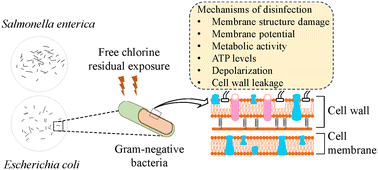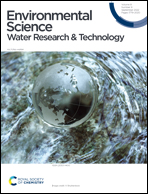Inactivation mechanisms of Escherichia coli O157:H7 and Salmonella enterica by free residual chlorine†
Abstract
The sub-cellular mechanisms by which residual free chlorine (FC) inactivates E. coli O157:H7 and S. enterica in the absence of organic matter was investigated. The average removal rates for E. coli were 38–99% after a 1 min exposure to 0.12–0.5 mg L−1 FC, while that of S. enterica were 10–50% after exposure to 0.5–2.0 mg L−1 FC. Chlorination caused significant membrane structural damage and reduced membrane potential. Low FC levels or short exposure times had a modest impact on S. enterica. Cell metabolic activity decreased over time for all initial FC levels, and with increasing FC levels at each time point. Total ATP levels increased in the first minute post-chlorination, while the intracellular ATP levels decreased with increasing FC levels and exposure time, likely due to ATP leakage. The depolarized E. coli density reached a plateau after the first 2 min at FC ≥ 0.5 mg L−1 while that of S. enterica took 5 min to reach a plateau even at FC ≥ 1 mg L−1, indicating their ability to withstand chlorination. Residual FC levels are sufficient to induce damage to cellular organelles and compromise their survival, and the mechanism of injury depends on FC levels and exposure time.

- This article is part of the themed collection: Environmental Science: Water Research & Technology Recent HOT Articles


 Please wait while we load your content...
Please wait while we load your content...
